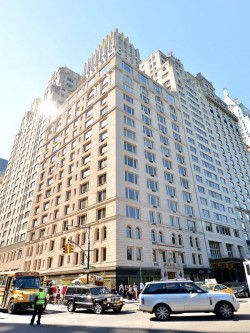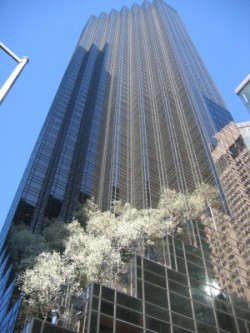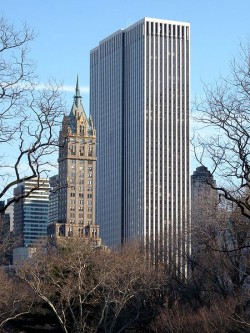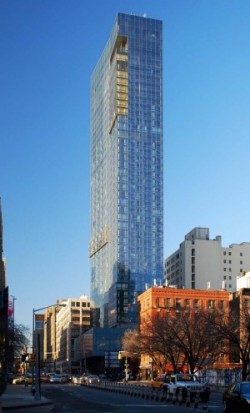“I don’t settle lawsuits – very rare – because once you settle lawsuits, everybody sues you – very simple,” said Republican front-runner Donald Trump during a press conference last week.
Trump’s aversion to making legal deals may go back decades – “You don’t use the term ‘settlement’ with Donald,” his attorney Roy Cohn told the New York Times more than 30 years ago – but he has in fact cut a few over his career.
The Real Deal looked at five major New York real estate cases where Trump got out while the gettin’ was good.

100 Central Park South
100 Central Park South (now Trump Parc East)
Trump bought this park-facing address with its neighbor, the Barbizon Hotel, in 1981, and quickly announced his plans to demolish them both. At the 15-story 100 Central Park South, Trump struggled to find any legal means of dismissing dozens of rent-regulated tenants. He famously offered that the City of New York let him house homeless people in the building and brought a number of lease violation suits against tenants, some of which were thrown out (and which Trump himself admitted were brought “stupidly” in his 1988 autobiography, “The Art of the Deal“). Meanwhile, the residents of the building sued Trump for harassment. In 1986, Trump and the tenants association struck an agreement. In exchange for dropping their harassment litigation, Trump dropped eviction proceedings against rent-controlled and rent-stabilized tenants and scrapped his plans to demolish the building. DHCR, the state affordable housing regulator, would monitor any forthcoming the luxury renovations.
Trump Spin: Thomas Macari, a Trump spokesperson at the time, said, “They [tenants] haven’t really won. They’ve lost because they wanted to buy their apartments.” In “The Art of the Deal,” Trump wrote that he had already decided not to demolish the building anyway, and said that because the Manhattan real estate market skyrocketed during the litigation, it actually benefitted him in the long run, as building condos on only the Barbizon site would now return more income than if he had knocked down and redeveloped both building sites at the time of purchase. “In effect, I was sitting on gold,” he wrote.
The Trump rental portfolio
In the early 1970s, the federal government brought an enormous housing discrimination action against Trump Management, the real estate company started by Donald Trump’s father, Fred Trump. The government alleged that the Trumps had discriminated against prospective tenants at dozens of rental properties across New York City, refusing to rent apartments to individuals on the basis of race. The Trumps settled in 1975, promising the government they would not discriminate and would personally read up on the Fair Housing Act. They also agreed to provide the Urban League with a list of available apartments every week for two years, as well as allow the Urban League to present the them with eligible tenants for vacancies at certain buildings.
Trump Spin: Donald Trump said the agreement was to his “full satisfaction” because it didn’t include a mandate to take tenants on welfare unless they were fully qualified. In “The Art of the Deal,” Trump wrote “we ended up making a minor settlement without admitting any guilt.”

Trump Tower at 721-725 Fifth Avenue
Trump Tower
In 1983, a housewreckers union member named Harry Diduck filed suit against Trump for cutting Laborers Local 95 out of $300,000 in benefit fund fees during the demolition of the Bonwit Teller Building, the art deco building Trump axed for the construction of Trump Tower. Much of the sum would pay out medical and pension benefits to Polish workers that had been contracted to work the Trump Tower site. The lawsuit went on for 15 years. In 1991, a federal judge ruled Trump and his partner Equitable had illegally withheld funds, conspiring with the head of the union. The estimated worth of the unpaid money with interest was upwards of $4 million. Trump appealed, but decided to settle in 1999 before it got any further. The year before, Trump said “It [settling] would be cheaper, but on principle I won’t… We did nothing wrong.”
Trump Spin: The settlement was sealed and Trump did not comment on it at the time. Marco Rubio claimed in a recent debate that Trump had paid out $1 million in a judgment, to which Trump interjected “wrong, wrong.” It is not known what the actual settlement payment was.
 GM Building
GM Building
Now the stuff of an upcoming Hollywood film, Donald Trump famously settled with his former partner Conseco Inc. in the sale of the GM Building in the early 2000s. With Conseco in bankruptcy, Trump wanted to buy the GM building all for himself. But the parties feuded over whether Trump, a stakeholder in the tower, actually had the means to do so. Trump later sued Conseco for $1 billion, claiming they blocked his bid, issuing an “improper demand” to obtain a letter of credit from Deutsche Bank as a term of the closing. Trump also claimed that the attacks of September 11th had made it impossible for him to find financing after Conseco delayed a September 6th, 2001 closing, causing him further damage.
Ultimately, an arbitration panel ordered Trump to sell his stake in the building to Conseco for $15.6 million. The panel’s order was later affirmed by a state Supreme Court judge. And, according to court documents obtained by The Real Deal, the $15.6 million check Conseco would write to Trump would only be a $4.5 million check, once city and state transfer taxes were subtracted. Trump motioned for contempt, but this was withdrawn when Trump entered into a confidential settlement with Conseco in summer of 2003.
Trump Spin: Though the precise terms of the agreement are secret, two sources briefed on the terms told the New York Times in 2003 that Trump ended up selling his stake to Conseco for $15.6 million after all, with Trump receiving a modest amount of the proceeds from Conseco’s full sale of the GM Building for $1.4 billion to Harry Macklowe. But the same day, the New York Post reported that, according to sources, Trump would be getting at least a $100 million pay out. “Both parties made a wonderful deal,” Trump said, declining to discuss the terms of the settlement.

Trump Soho at 246 Spring Street
Trump Soho
The developers of the Trump-branded condo-hotel at 246 Spring Street refunded 90 percent of security deposit dollars to 15 buyers, including French soccer star Olivier Dacourt, when those buyers sued over “deceptive” marketing tactics. Donald Trump, who was not a co-developer but whose company manages the building and was involved in marketing the units along side Bayrock Group and Sapir Organization, was named defendant in the suit. The plaintiffs claimed that Trump and the other defendants misled them by publicly reporting that 60 percent of Trump Soho’s units were already sold when in reality just over 15 percent had. To dissuade buyers from joining the suit, the developers offered to refund half the deposits to buyers who had not yet closed on their condos. The plaintiffs who did participate in the action, however, reached a settlement for bigger refund payouts in 2011.
Trump Spin: Trump did not comment on the lawsuit at the time, but did say that it was probably a good idea for the developers to change unsold units from condo-hotel to just regular hotel (especially once everyone knew what the real sales numbers were). “Business is so strong that we’re delighted to get the units back,” Trump’s daughter Ivanka said at the time, a positive take bearing an uncanny resemblance to something her father might have written in “The Art of the Deal.”
